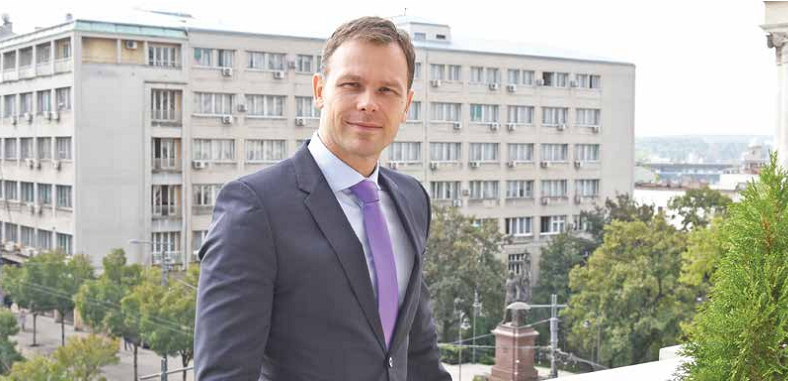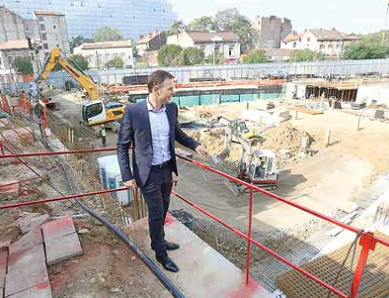Belgrade Mayor Siniša Mali is proud of the number of active construction sites in our capital city and the investment boom that Belgrade is experiencing, which is not to the detriment of the rest of Serbia. Indeed, on the contrary, projects like the Belgrade Waterfront are a driving force behind the growth of the country
Although the implementation of the new Law on Financing Local Self-Governments will mean that our capital city will have its funds slashed, Belgrade Mayor Siniša Mali is confident that the city will be able to implement all large-scale projects that have been carefully developed. Although foreign media often compare Belgrade to Berlin, and Mayor Mali agrees that these two cities have similar creativity and urban spirit, Belgrade is still a special city that has been changing constantly, with each new construction site and investment boom.
What is the city’s financial situation like? How much will amendments to the Law on Financing Local Self-Governments affect the city’s finances?
— The situation is much better than the one we found when we took over managing the city administration. If the City of Belgrade had continued to function in the old way, it would have gone bankrupt for sure, as clearly indicated by the relevant reports and data. We were met with debts of 1.1 billion euros and a budget deficit exceeding 20%. We have managed to settle 250 million euros worth of the debt and reduce the budget deficit almost fourfold. In order to achieve this, we had to consolidate public enterprises, implement certain austerity measures and practically bring order to the city’s affairs without borrowing a single Dinar. I am satisfied with the results and I think we are moving in the right direction. As far as the draft Law on Financing of Local Self-Governments is concerned, the City will support it and we are willing to make some cutbacks. We have stable revenue; we settle our financial obligations on time and are stable enough to carry this burden. We have been a good partner to the government since the very beginning and we are in this together.
Could we say that largescale projects in Belgrade are making the rest of Serbia less relevant, or are they the driving force in the country?
— Not a single project that we have been implementing is to Serbia’s detriment, on the contrary… It is a well-known fact that capital cities are the driving force behind a country’s development and that they push a country forward. This is our goal, i.e., for our successfully implemented projects to foster the growth of the entire country. Belgrade’s share in Serbia’s GDP is 40%, and this is the real indicator of how important it is for the city to develop. Take the Belgrade Waterfront project, for instance. This project is boosting the country’s entire construction industry, engaging hundreds of workers and improving Serbia’s image in the world. Belgrade and Serbia have become recognisable elsewhere in the world because of this project, and whenever we have an investor, a journalist or even a tourist coming to this country, they are always interested in hearing about the Belgrade Waterfront.
When it comes to the Belgrade Waterfront, how much infrastructure does the City have to provide and how does this affect the infrastructure in other parts of Belgrade?
— The Belgrade Waterfront is significant for several reasons. Apart from completely changing the city’s future and turning its ugliest part into the most attractive one, the project also motivates us to complete other projects that have remained dormant for decades. Project investors are in charge of the project’s infrastructure, while the Serbian Government has to provide infrastructure to the border of the Belgrade Waterfront. As a result, we are going to get a gas pipeline from Bežanijska Kosa to Padinska Skela and a rainwater collection system. One should bear in mind that the problem of waste water and rainwater drainage has been going on for thirty years now. Also, thanks to the Belgrade Waterfront, we have com pleted the first stage in construction of the Prokop railway station and we are currently working on access roads. We are also relocating the bus station to Block 42 and, as a result, this bus station will finally have a contemporary appearance of which we will all be proud.
Why is PKB still not privatised, despite Chinese investors having expressed their strong interest in the company’s privatisation? What is the logic behind transferring the ownership of PKB to the Serbian Government?
— So far, there has been no serious interest shown in the privatisation of PKB, which is the reason why it is still not privatised. However, we met with top officials from Beijing in Belgrade recently, who reiterated their interest in PKB. They also mentioned that, back in the 1970s, when China started to develop rapidly, they used to come to PKB to copy our experiences. In terms of transferring the ownership of PKB to the state government, the logic behind this move is found in the Privatisation Law, which stipulates that only the state government, and not local self-governments, can conclude strategic partnership agreements. The law stipulates strategic partnership as a privatisation format that is applicable only to state-owned companies. This suits our requirements when it comes to PKB. The law also stipulates so-called relief measures or additional options for settling the company’s debt. All of this gives us more options that were not previously legally available to the City of Belgrade.
Could you tell us something about the latest developments regarding other investments – Mei Ta, IKEA, Lidl and others?
— We experienced a real investment boom last spring, when several large and important facilities started being built in the city. Apart from the investments you’ve mentioned, there is the construction of the Hilton Hotel, which I visited recently, and several facilities for the Belgrade Waterfront project, where hundreds of workers are engaged around the clock. In April alone, ongoing projects were worth 400 million euros. All of these projects are developing according to plan and the envisaged dynamics. Indeed, Belgrade has become a city of lifts and cranes, just as we promised. I am proud of the numerous construction sites in the city and the fact that there is more to come.
Do you see Belgrade as the ‘new Berlin’? How similar or different are these two cities? Why is Belgrade still not considered “the city of museums” and why was the initiative to open a jazz museum rejected?
— Belgrade should not become the new Berlin. Belgrade is a city unto itself, with very unique virtues and flaws. There are many reasons why tourists come to Belgrade and maybe, in that respect, it is similar to Berlin, which is good because we are moving forward, developing and have a lot to offer young people. In the context of a contemporary creative city, Belgrade does resemble Berlin, and we should definitely look up to European cities. We did not reject the idea of opening the Jazz Museum. This music legacy is supposed to be implemented as a joint project of Heritage House and Belgrade’s Dom Omladine Youth Centre. The project is currently being developed and the next stage is to secure funding and implement it.
How much does the city’s current financial situation determine its main development priorities and the financing of large projects, like a metro?
— When planning investment projects that will be developed in the city in the coming period, we start with the priorities set out in the strategic documents devised both by the City and the state government, as well as by analysing the financial impact on the City budget. The City uses a special analytical tool developed by the World Bank which facilitates long-term financial forecasting. Not a single project is implemented without us first analysing how much it is going to cost, for both the budget and the taxpayers. The projects that are under development are financially sustainable, have not significantly affected utility prices and will be implemented with saved budget funds, i.e. some of the costs will be covered by private partners through public-private partnerships. Some projects will even generate additional public revenue, through concession fees and similar charges.
Which projects will be implemented through public-private partnerships and are they really that necessary? For instance, do you think the project of installing LED lighting will have the same destiny as the rubbish containers that proved to be a bad investment?
— Apart from public-private part-nerships (PPP) in projects relating to city and intercity transport and the landfill in Vinča, which was approved by the State Committee for Public-Private Partnerships, we have three other large-scale projects that will be funded through PPP, namely street furniture, underground parking garages and replacing street lighting in suburban areas of Belgrade in line with the ESCO model, where the money for the project has been generated from lower electricity bills. Once these projects are implemented, Belgrade will become a local self-governing unit with the highest number of PPP projects in Serbia. This is all in the hands of a dedicated team of people in my cabinet that was formed following the adoption of the Investment Law. All of our projects are carefully and meticulously developed in order to be successfully implemented in the best interests of our citizens and in a way that ensures my successors can be proud of them.
Who is in charge of solving the problem with the Sava Centre – the state or the City? What else is Belgrade doing to become a regional conference hub?
— The problem with the Sava Centre is being handled together by the state and the City government, all with a view to turning Belgrade into the regional conference capital, bearing in mind that the city has the biggest conference centre in the Balkans. The idea is to involve the private sector in finishing reconstruction of the Sava Centre, increase its energy efficiency and reduce its heating and electricity bills, as well as to appoint professional managers who will make it more contemporary and bring as many international conferences here as possible. This will have significant external effects on the entire conference industry, including airline companies, hospitality and the catering industry. We do hope that all of this will have been finished by year’s end, in order for the reconstruction to start in 2017.
Apart from being a centre of culture and nightlife, Berlin is also one of the most interesting IT hubs in Europe. How can we emulate this?
— We can definitely emulate that, considering how big the potential of our IT sector is. Together with the Serbian government, we are going to devise support measures and incentives for this industry, which generates huge foreign currency revenue and showcases Serbian intelligence to the world in the best possible way. I agree that, apart from its hospitality, exciting nightlife and tasty food, Belgrade also has a lot of young, capable and creative people who closely follow global trends. As a City government, we are ready to support them in every way possible, and I am confident that we will be successful in that.

